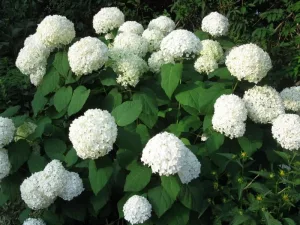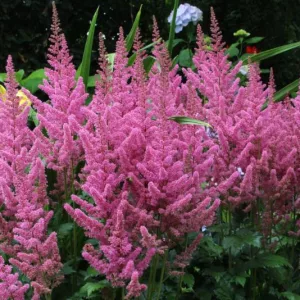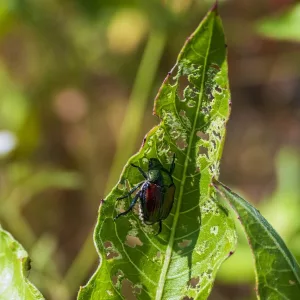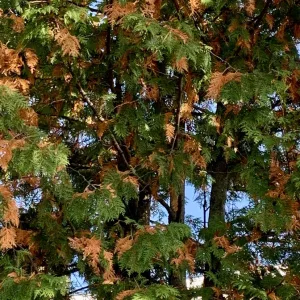I will be continuing with the series of answering common timely questions. This week I have been asked about supporting and pruning hydrangea; lawn pests; shrubs suitable for planting in damp areas; and how to battle beetles on roses.
I know that when the Hydrangea arborescens ‘Annabelle’ come into bloom with their big globe-shape, white flowers I get asked about staking. A lot of times the flower heads are so big and heavy that they flop over, especially right after a rain.
You can stake up the branches if they do flop over, but a better idea is the support the entire shrub starting in early spring, so when flowers form the branches stay upright. You can use a large tomato cage or peony ring for a small shrub. A larger shrub may need stakes put around the outside of the stems instead. As stems and foliage grow, put twine around the stakes. Add another layer of twine as the growth gets taller. Once the flowers form, foliage will have hidden the supports and flowers will stay upright on the stems. This allows the shrub to maintain a natural shape. Tying up after the stems have already flopped over can make the shrub look very ‘pulled together’ and unnatural.
Most paniculate type hydrangeas can support the weight of the flowers on their own, if grown in enough sunlight. You may have to support stems if the shrub is in part shade.
I get questions about pruning hydrangeas right now too. The general rule of thumb for all the hydrangeas except the macrophylla types, is to prune in early April before the new growth begins. All flowers form on new growth. Remove one third to one half of the previous year’s stem length for the paniculate types. The Annabelle’s can be pruned harder if need be.
The Macrophylla Hydrangea types that turn pink or blue depending on soil pH, should be left unpruned in spring until you see where new growth is emerging. Then just prune away dead wood. Flowers for most of these types form on new growth that emerges from old wood.
The major lawn pest doing damage now is Chinch Bug. If you have expanding dead areas in your lawn, check for this pest by using this method: remove the bottom and top of a large tin can; push the cylinder into the lawn in healthy grass just on the verge of the dead area; fill the can with water. If you have Chinch Bug, they will float to the water surface. Once identified, you can use the correct product to treat this pest.
This has been quite a rainy summer so far. If you are looking to add shrubs to an area that is a bit boggy or wet after a rain but does not hold standing water for more than a day or two, consider one of the shrub willows or dogwoods. Be sure to look at light conditions that area receives and think about the mature size you want to shrub to be before you choose what to plant. You want to be happy with your choice for years to come!
Several different beetle species feed on roses. Many of these pests feed mainly on flower buds or open blossoms but can also eat leaves. Since some beetles feed mainly at night, you may have to go out after dusk with a flashlight to identify the bug doing damage. One major problem gardeners faced last season was Japanese beetles. When they arrive, they can decimate a plant in a day! I have not heard reports of much damage yet but be on the lookout!
There is a biological control for beetles now in the form of a wettable powder that can be applied to foliage. The beetles ingests the product and perishes. It contains a naturally occurring soil microorganism called Bacillus thuringiensis galleriae. ‘This natural active ingredient targets susceptible beetles and grubs with no adverse effects to desirable insects like bees, butterflies, and ladybugs when used according to label directions.’ Allows be sure to use the correct pest solution and follow application directions.




